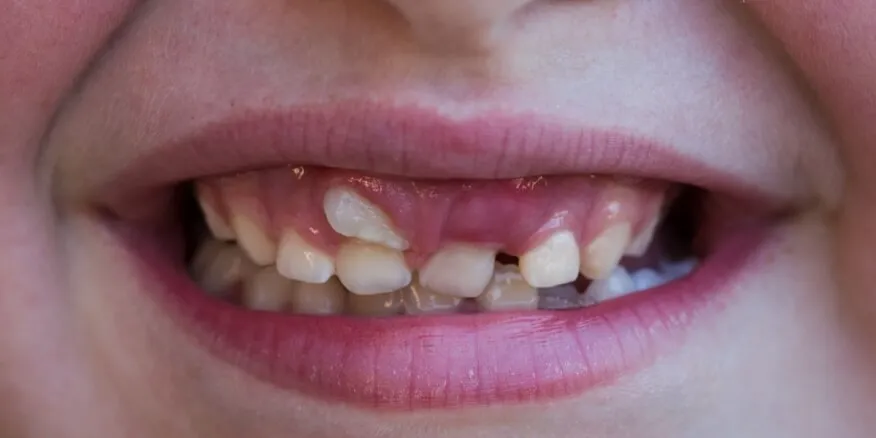The teething period is one of the most important stages of a child’s development, as his first teeth begin to appear and are accompanied by some challenges and surprises. Among these surprises, parents may notice the appearance of their child’s back teeth, which may raise concerns and questions about the reasons behind this. This phenomenon is relatively uncommon and can be the result of several factors, including genetic, environmental, and others related to oral health and normal tooth development. In this article, we will discuss in detail the most prominent reasons that lead to the appearance of back teeth in children, while providing tips and instructions to help parents deal with this condition in a sound and reassuring manner.
What are back teeth?
Back teeth, also known as molars or molars, are the teeth located at the back of the mouth and include the front molars (primary or first molars) and the back molars (permanent molars). These teeth play a vital role in the process of chewing and grinding, and they are larger and stronger than the front teeth due to the nature of the functions they perform.
Types of back teeth
- Primary molars:
These teeth appear during childhood and are part of the set of baby or primary teeth. They usually begin to appear at the age of one to two years and continue until the child begins to lose his baby teeth at the age of six to seven years.
- Permanent molars:
Permanent molars begin to emerge after the loss of baby teeth. Permanent first molars usually appear around the age of six, and second molars around the age of twelve. Third molars, also known as wisdom teeth, usually appear in the late teens or early twenties.
What are the functions of a child’s back teeth?
A child’s back teeth, also known as baby molars, play an important role in the child’s oral development and overall health. Although they are temporary teeth, they have vital functions that require care and attention to ensure proper development of the teeth and jaw. Here are some of the main functions of back teeth in children:
- Chewing and grinding:
The primary function of molars is to grind food into small pieces to facilitate digestion. Chewing well helps in better digestion and better absorption of nutrients.
- Help with pronunciation:
Back teeth contribute to the development of proper speech in children. Teeth help in forming sounds and words correctly, which helps the child learn to speak clearly.
- Preserving space for permanent teeth:
The back teeth act as space keepers for the permanent teeth to grow properly. Premature loss of baby teeth may lead to problems with the alignment of permanent teeth.
- Support jaw growth and facial shaping:
Baby molars help support jaw development and shape facial structure. They help maintain the correct distance and balance between the upper and lower jaw, which directly affects the appearance of the face.
- Develop healthy eating habits:
Molars contribute to helping the baby eat a variety of solid foods, which encourages the development of healthy eating habits. Chewing well enhances taste and encourages proper eating.
- Prevent future dental problems:
Taking good care of baby molars helps prevent future dental problems, such as cavities and gum infections. Maintaining healthy baby teeth promotes overall oral health and reduces the need for complex treatments in the future.
What are the harms of the appearance of back teeth to a child?
The appearance of back teeth in children can be accompanied by some damage and health problems, which may affect the mouth and jaws in general. Here are some possible damages to the appearance of back teeth in children:
- Pain and discomfort:
Children may experience pain and discomfort as their back teeth grow, and this can cause irritation and disruptive behaviour. In some cases, pain may affect sleep and feeding.
- Gingivitis:
Growing back teeth may cause inflammation of the surrounding gums, leading to redness, swelling, and pain in the gums. This inflammation can make the child uncomfortable and make it more difficult to maintain oral hygiene.
- Problems with tooth alignment:
If the back teeth do not appear in their correct positions, this can lead to problems with the alignment of the teeth. These problems can affect the correct arrangement of teeth and cause jaw misalignments.
- Increased risk of caries:
Back teeth may be more susceptible to decay because they are more difficult to reach and clean properly. The buildup of plaque and food debris in these teeth can increase the risk of tooth decay.
- Effects on chewing food:
Children may have difficulty chewing food properly as their back teeth develop, which can affect overall digestion and nutrition.
- Speech problems:
Irregular back teeth may affect a child’s ability to speak correctly, which can lead to problems learning to speak and communicate.
- Tooth abscesses:
In some cases, abscesses may develop around new back teeth, causing severe pain and requiring medical treatment.
In conclusion, the appearance of back teeth is a natural and important stage in a child’s development, but it may come with some challenges and health problems that require attention and extreme care. It is important for parents to be aware of the potential damage associated with the eruption of these teeth, such as pain, gingivitis, and problems with tooth alignment. Through good oral care and regular follow-up with the dentist, this damage can be mitigated and the child’s teeth can be healthy and healthy. Remember, early attention to children’s oral health not only contributes to their current health, but also establishes a strong foundation for lifelong oral health.
Related articles :
Hollywood smile in Istanbul
advantages of cosmetic dentistry in Turkey
Plastic surgery in Istanbul
Dental treatment cost in Turkey
advantages of laser teeth whitening in Istanbul
Types and risks of dental implants in Turkey
hair transplant techniques in Istanbul
Dental veneers in Turkey
Hair transplantation in Turkey
Types of orthodontics in Istanbul and their features
